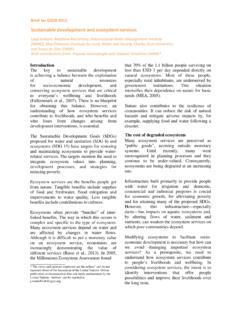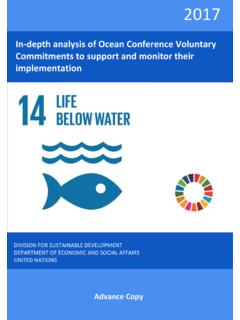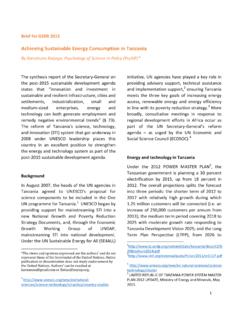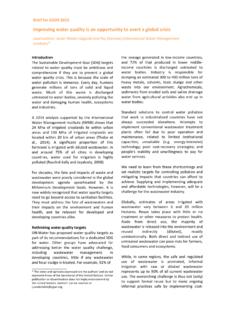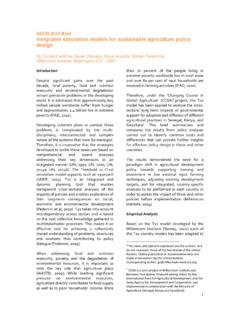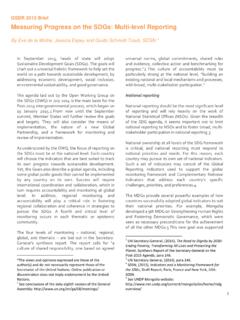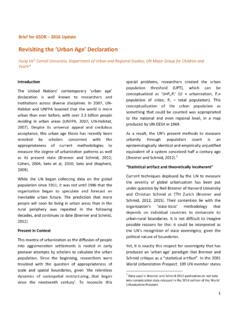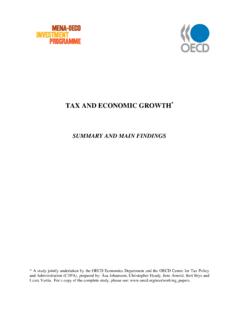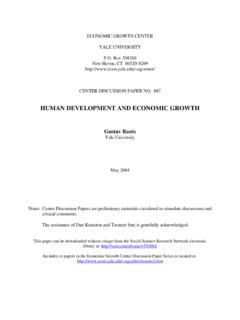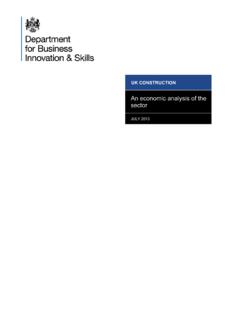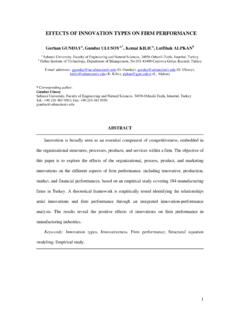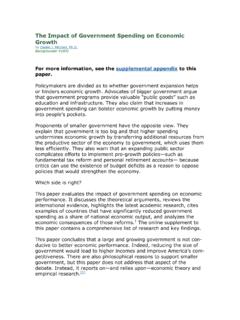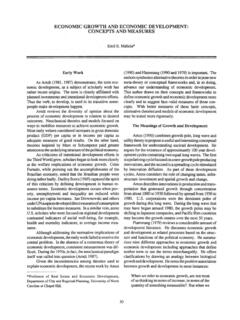Transcription of Innovation, Economic Development and Intellectual Property ...
1 1 GSDR Prototype Briefs | 2014 In search of Optimality: innovation , Economic Development , and Intellectual Property Rights By William Daley, The Fletcher School of Law and Diplomacy, Tufts University Introduction innovation is largely considered to be the principle catalyst of long-term Economic growth . Therefore, what is the ideal method to spur innovation ? In addition to other factors, Intellectual Property rights (IPR) and their relative degree of severity play an important role in technology Development and diffusion. This paper explores the controversial and polarizing nature of IPR: one side falls in support of all-encompassing and stringent regulation while the other side remains critical of such a stance.
2 However, recent research suggests that the internationally optimal solution lies not at the extremes, but somewhere in between. Intellectual Property refers to the protection of innovations of the mind. Through a legal framework, owners of such Property receive specific rights, which may be used for recognition or financial gain. The mechanisms by which Intellectual Property is protected include copyrights, patents, trademarks, industrial designs, and geographic indications. Governments and certain ruling bodies determine the equilibrium point among the various stakeholders: By striking the right balance between the interests of innovators and the wider public interest, the IP system aims to foster an environment in which creativity and innovation can flourish.
3 (WIPO) This equilibrium, and the process by which it is achieved, is the source of constant debate. The aforementioned mechanisms of Intellectual Property protection generally exist within the developed world. However, developing countries traditionally lack a modern, enforced, or efficient Intellectual Property system. The Agreement on Trade Related Aspects of Intellectual Property Rights (TRIPS) is an international accord establishing uniform guidelines for Intellectual Property protection. In principle, TRIPS applies to all WTO members, although important exceptions exist, and focuses on minimum standards, non-discrimination policies, and enforcement and dispute settlement mechanisms.
4 The WTO affirms the net gain of TRIPS: Society benefits in the long term when Intellectual Property protection encourages creation and invention, especially when the period of protection expires and the creations and inventions enter the public domain. Governments are allowed to reduce any short term costs through various exceptions, for example to tackle public health problems. (WTO) Nevertheless, despite this apparent commitment to a mutually advantageous international system, the debate rages on. The Case in Favor of Strong IPR Protection The United States, along with many developed countries, is a spirited proponent of IPR and TRIPS, affirming the agreement s ability to foster long-term Economic growth and national Development .
5 Industrialized nations receive international protection from Intellectual Property infringement and developing countries receive increases in trade, foreign direct investment (FDI), and technology generation and diffusion. Therefore, all members benefit from TRIPS. IPR protection has the ability to encourage innovation and the formation of a well-functioning market system in developing 2 countries, both of which lead to Economic growth . (Chen and Puttitanun 490) System strength and proper enforcement are critical components of this positive relationship between IPR and Economic Development .
6 (Eicher and Newiak 19) In addition, empirical evidence exists to support the claim that the TRIPS-induced patent duration increase, which mandates a minimum of twenty years, has spurred innovation . (Abrams 1639-42) Using a sample of developing countries in the post-TRIPS era, one study measures the impact of national IPR level on FDI and imports. The findings of this empirical analysis reveal a positive relationship: On average, the results indicate a one point increase in the IPR score (about 10 percent) will increase a country s FDI by $ billion (50 percent of the mean amount) and imports by $ billion (40 percent of the mean amount).
7 (Lesser 19) As a result, developing countries should consider this positive relationship when devising IPR policy. The empirical results from another study, which examines a diverse country panel from 1990- 2005, confirm two hypotheses: (1) IPR encourage technology transfer and (2) IPR stimulate domestic innovation . (Park and Lippoldt 4) For example: On the whole, the estimates suggest that a 1% strengthening of patent rights is associated with a more than 2% increase in the stock of inward FDI. (Park and Lippoldt 20) IPR protection promotes inward FDI and imports which, in turn, spurs technology transfer: goods, services, and capital are a source of knowledge as well as a source of inputs with which to conduct innovation .
8 (Park and Lippoldt 5) The positive relationship between developing country IPR and technology transfer is especially seen in high-tech products, such as chemicals, aerospace, and computer services. (Park and Lippoldt 28) The Case Against Strong IPR Protection A growing contingent of scholars, policymakers, and practitioners argue the disadvantages of TRIPS for developing countries. Proponents of this view criticize the assertion that strong IPR systems foster across-the-board innovation and Economic growth . Furthermore, even if theoretical incentives for innovation and technology transfer exist as a result of Intellectual Property protection, this does not necessarily engender sustainable Development : IPR may provide an incentive for innovation but there is limited local capacity in LDCs to make use of if stronger IP protection supports an increase in technology transfer, limited local absorptive capability may limit the potential to use it.
9 (L ger, Developing Countries, 2) Similarly, various studies indicate the existence of a crowding out effect: the IPR induced influx of FDI and foreign technology reduces domestic innovation incentive and capacity, which impedes long-term Economic growth in developing countries. (Jin, Garcia and Salomon) Various studies support the case against universally stringent IPR. Results from an empirical analysis , which focuses on a panel dataset comprised of 22 developed and 76 developing countries and a time span of 30 years (1965-1995), find Intellectual Property protection and past R&D investments to have a positive and significant impact on innovation in developed countries but not in developing countries, thus indicating a divergence in the determinants of innovation .
10 (L ger, Around the World, 24) Furthermore, research published in the Journal of World Business, which analyzed 18 Latin American and Caribbean developing countries from 1990-2003, challenges the positive relationship between IPR and FDI: We find that with each point increase [in IPR reform] there is a decrease in FDI per Model decrease per the results of Models 2 and 3. (Khoury and Peng 17) Whereas Intellectual Property protection is generally understood to foster innovation and Economic growth in developed countries, the same cannot be definitively stated for developing countries. 3 At low levels of Economic Development , rigorous IPR systems are likely to discourage innovation and Economic growth .
